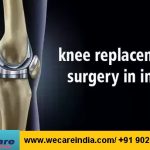CRANIOTOMY
Craniotomy is a cut that opens the cranium. During this surgical procedure, a section of the skull, called a bone flap, is removed to access the brain underneath. The bone flap is usually replaced after the procedure with tiny plates and screws.
A craniotomy may be small or large depending on the problem. It may be performed during surgery for various neurological diseases, injuries, or conditions such as brain tumors, hematomas (blood clots), aneurysms or AVMs, and skull fractures. Other reasons for a craniotomy may include foreign objects (bullets), swelling of the brain, or infection. Depending on the reason for the craniotomy, this surgery requires a hospital stay that ranges from a few days to a few weeks.

What is a craniotomy?
Craniotomy is any bony opening that is cut into the skull. A section of skull, called a blone flap, is removed to access the brain underneath. There are many types of craniotomies, which are named according to the area of skull to be removed . Typically the bone flap is replaced. If the bone flap is not replaced, the procedure is called a craniectomy.
Craniotomies are also named according to their size and complexity. Small dime-sized craniotomies are called burr holes or keyhole craniotomies. Sometimes stereotactic frames, image-guided computer systems, or endoscopes are used to precisely direct instruments through these small holes.
Burr holes or keyhole craniotomies are used for minimally invasive procedures to in India : –
- insert a shunt into the ntricles to drain cerebrospinal fluid (hydrocephalus)
- insert a deep brain stimulator to treat Parkinson Disease
- insert an intracranial pressure (ICP) monitor
- remove a small sample of abnormal tissue (needle biopsy)
- drain a blood clot (stereotactic hematoma aspiration)
- insert an endoscope to remove small tumors and clip aneurysms
Large or complex craniotomies are often called skull base surgery. These craniotomies involve the removal of a portion of the skull that supports the bottom of the brain where delicate cranial nerves, arteries, and veins exit the skull. Reconstruction of the skull base is often necessary and may require the additional expertise of head-and-neck, otologic, or plastic surgeons. Surgeons often use sophisticated computers to plan these craniotomies and locate the lesion.
Skull base craniotomies can be used to in India : –
- remove or treat large brain tumors, aneurysms, or AVMs
- treat the brain following a skull fracture or injury (e.g., gunshot wound)
- remove tumors that invade the bony skull
There are many kinds of craniotomies. Ask your neurosurgeon to describe where the skin incision will be made and the amount of bone removal.
Who performs the procedure?
A craniotomy is performed by a neurosurgeon; some have additional training in skull base surgery. A neurosurgeon may work with a team of head-and-neck, otologic, oculoplastic and reconstructive surgeons. Ask your neurosurgeon about their training, especially if your case is complex.
What happens before surgery?
You will typically undergo tests (e.g., blood test, electrocardiogram, chest X-ray) several days before surgery. In the doctors office you will sign consent forms and complete paperwork to inform the surgeon about your medical history (i.e., allergies, medicines, anesthesia reactions, previous surgeries). You may wish to donate blood several weeks before surgery. Discontinue all non-steroidal anti-inflammatory medicines (Naproxin, Advil, etc.) and blood thinners (coumadin, aspirin, etc.) 1 week before surgery. Additionally, stop smoking, chewing tobacco, and drinking alcohol 1 week before and 2 weeks after surgery because these activities can cause bleeding problems.
What happens during surgery?
There are 6 main steps during a craniotomy. Depending on the underlying problem being treated and complexity, the procedure can take 3 to 5 hours or longer.
Step 1 : – Prepare The Patient No food or drink is permitted past midnight the night before surgery. Patients are admitted to the hospital the morning of the craniotomy. With an intravenous (IV) line placed in your arm, general anesthesia is administered while you lie on the operating table. Once asleep, your head is placed in a 3-pin skull fixation device, which attaches to the table and holds your head in position during the procedure. Insertion of a lumbar drain in your lower back helps remove cerebrospinal fluid (CSF), thus allowing the brain to relax during surgery. A brain-relaxing drug called mannitol may be given.
Step 2 : – Make A Skin Incision After the scalp is prepped with an antiseptic, a skin incision is made, usually behind the hairline. The surgeon attempts to ensure a good cosmetic result after surgery. Sometimes a hair sparing technique can be used that requires shaving only a 1/4-inch wide area along the proposed incision. Sometimes the entire incision area may be shaved.
Step 3 : – Perform A Craniotomy, Open The Skull The skin and muscles are lifted off the bone and folded back. Next, one or more small burr holes are made in the skull with a drill. Inserting a special saw through the burr holes, the surgeon uses this craniotome to cut the outline of a bone flap. The cut bone flap is lifted and removed to expose the protective covering of the brain called the dura. The bone flap is safely stored until it is replaced at the end of the procedure.
Step 4 : – Exposure The Brain After opening the dura with surgical scissors, the surgeon folds it back to expose the brain . Retractors placed on the brain gently open a corridor to the area needing repair or removal. Neurosurgeons use special magnification glasses, called loupes, or an operating microscope to see the delicate nerves and vessels.
Step 5 : – Correct The Problem Because the brain is tightly enclosed inside the bony skull, tissues cannot be easily moved aside to access and repair problems. Neurosurgeons use a variety of very small tools and instruments to work deep inside the brain. These include long-handled scissors, dissectors and drills, lasers, ultrasonic aspirators (uses a fine jet of water to break up tumors and suction up the pieces), and computer image-guidance systems. In some cases, evoked potential monitoring is used to stimulate specific cranial nerves while the response is monitored in the brain. This is done to preserve function of the nerve and make sure it is not further damaged during surgery.
Step 6 : – Close The Craniotomy With the problem removed or repaired, the retractors holding the brain are removed and the dura is closed with sutures. The bone flap is replaced back in its original position and secured to the skull with titanium plates and screws . The plates and screws remain permanently to support the area; these can sometimes be felt under your skin. In some cases, a drain may be placed under the skin for a couple of days to remove blood or fluid from the surgical area. The muscles and skin are sutured back together. A turban-like or soft adhesive dressing is placed over the incision.
What happens after surgery?
After surgery, you are taken to the recovery room where vital signs are monitored as you awake from anesthesia. The breathing tube (ventilator) usually remains in place until you fully recover from the anesthesia. Next, you are transferred to the neuroscience intensive care unit (NSICU) for close observation and monitoring. You are frequently asked to move your arms, fingers, toes, and legs.
A nurse will check your pupils with a flashlight and ask questions, such as “What is your name?” You may experience nausea and headache after surgery; medication can control these symptoms. Depending on the type of brain surgery, steroid medication (to control brain swelling) and anticonvulsant medication (to prevent seizures) may be given. When your condition stabilizes, you’ll be transferred to a regular room where you’ll continue to be monitored and begin to increase your activity level.
The length of the hospital stay varies, from only 2-3 days or 2 weeks depending on the surgery and development of any complications. When released from the hospital, you’ll be given discharge instructions. Stitches or staples are removed 7-10 days after surgery in the doctor’s office.
When to Call Your Doctor in India
If you experience any of the following : –
- A temperature that exceeds 101º F
- An incision that shows signs of infection, such as redness, swelling, pain, or drainage.
- If you are taking an anticonvulsant, and notice drowsiness, balance problems, or rashes.
- Decreased alertness, increased drowsiness, weakness of arms or legs, increased headaches, vomiting, or severe neck pain that prevents lowering your chin toward the chest.

Discharge instructions in IndiaDiscomfort
- After surgery, headache pain is managed with narcotic medication. Because narcotic pain pills are addictive, they are used for a limited period (2 to 4 weeks). Their regular use may also cause constipation, so drink lots of water and eat high fiber foods. Laxatives (e.g., Dulcolax, Senokot, Milk of Magnesia) may be bought without a prescription. Thereafter, pain is managed with acetaminophen (e.g., Tylenol) and nonsteroidal anti-inflammatory drugs (NSAIDs) (e.g., aspirin; ibuprofen, Advil, Motrin, Nuprin; naproxen sodium, Aleve).
- A medicine (anticonvulsant) may be prescribed temporarily to prevent seizures. Common anticonvulsants include Dilantin (phenytoin), Tegretol (carbamazepine), and Neurontin (gabapentin). Some patients develop side effects (e.g., drowsiness, balance problems, rashes) caused by these anticonvulsants; in these cases, blood samples are taken to monitor the drug levels and manage the side effects.
- Restrictions
- Do not drive after surgery until discussed with your surgeon and avoid sitting for long periods of time.
- Do not lift anything heavier than 5 pounds (e.g., 2-liter bottle of soda), including children.
- Housework and yardwork are not permitted until the first follow-up office visit. This includes gardening, mowing, vacuuming, ironing, and loading/unloading the dishwasher, washer, or dryer.
- Do not drink alcoholic beverages.
Activity
- Gradually return to your normal activities. Fatigue is common.
- An early exercise program to gently stretch the neck and back may be advised.
- Walking is encouraged; start with short walks and gradually increase the distance. Wait to participate in other forms of exercise until discussed with your surgeon.
Bathing/Incision Care
- You may shower and shampoo 3 to 4 days after surgery unless otherwise directed by your surgeon.
- Sutures or staples, which remain in place when you go home, will need to be removed 7 to 14 days after surgery. Ask your surgeon or call the office to find out when.







